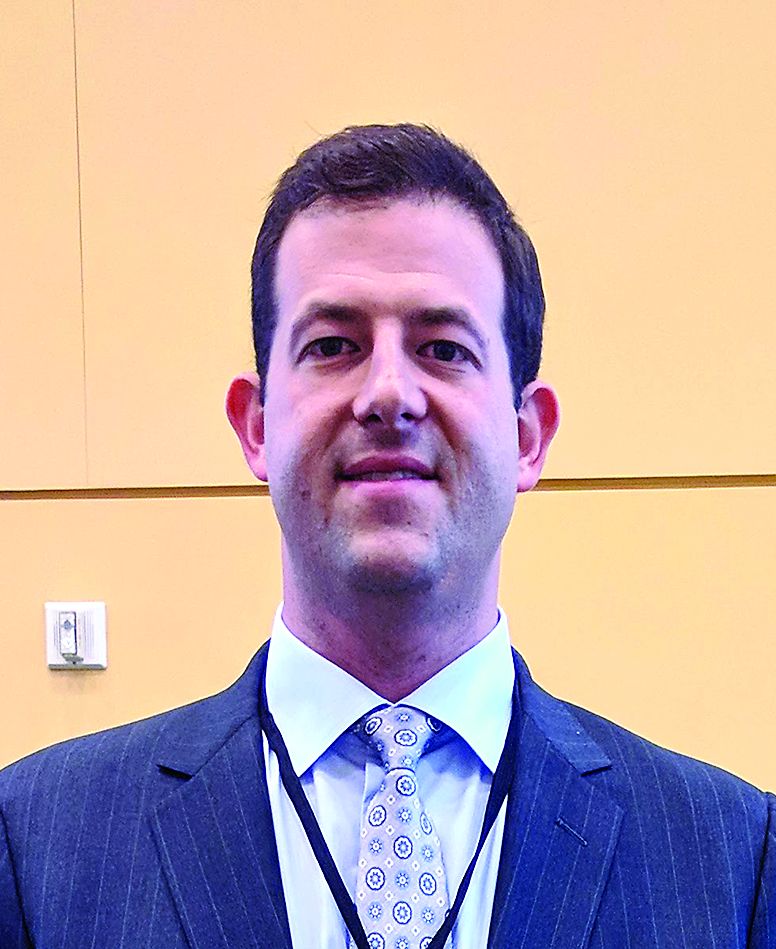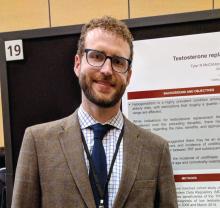User login
Partial nephrectomies on rise for early-stage RCC
SAN FRANCISCO – Partial nephrectomy for localized renal cell carcinomas (RCCs) is on the rise, but the procedure is still less commonly performed than radical nephrectomy and more commonly performed at high-volume surgical centers.
About half of localized renal tumors are excised through partial nephrectomy, based on results from a new analysis of The National Cancer Database. The study also indicated that patient mortality rates were lower at high volume centers, those in the top 10 percentile of treatment volume, said David Cahn, DO, who presented the results at the annual meeting of the American Urological Association.
The study looked at surgeries among 142,000 patients with pT1a-T2b RCCs (no involvement of lymph nodes or metastases) who underwent procedures during 2004-2014.
Overall, 41% of patients had partial nephrectomies, 58% had radical nephrectomies, and 1% received ablative therapy. The frequency of partial nephrectomies rose markedly over the course of the study, increasing from 24% of cases in 2004 to 53% in 2014. The vast majority of partial nephrectomies, 81%, were performed for pT1a tumors; 24% of pT1b tumors also were excised using partial nephrectomy.
Compared with the reference point of T1a tumors, T1b tumors (odds ratio, 0.22; P less than .0001), T2a (OR, 0.06; P less than .0001), and T2b tumors (OR, 0.03; P less than .0001) were progressively less likely to be treated with partial nephrectomy. A multivariate analysis showed that patients at a high volume center were significantly more likely to undergo partial nephrectomy (OR, 1.89; P less than .0001). Overall mortality was lower at high volume centers (hazard ratio, 0.92; P = .012).
“I think that regionalization of care has ... some benefits to patients, but it comes with many challenges as well. This study really did help show that increased numbers [of procedures performed] makes you more comfortable and willing to offer partial nephrectomy,” said Dr. Cahn, of Fox Chase Cancer Center, Philadelphia.
“Volume tends to show better outcomes. But the concern is: Are you overloading systems? Are you making patients travel farther, and how does that work in terms of follow-up care?” Dr. Cahn said. He cited the example of a patient who may have to travel several hours to get surgery but then returns home and develops a postoperative complication that must be treated in a different facility. That raises issues of transfer of medical records and coordination of care.
The solution, he said, is for some of the procedures and practices common at high-volume centers to be transferred to smaller centers. “For the routine partial nephrectomy ... we need to have well-trained physicians who can offer those all over the country. I think it’s too hard in terms of feasibility to push those patients just towards certain high volume centers.”
SOURCE: AUA Annual Meeting, Abstract PD07-04.
SAN FRANCISCO – Partial nephrectomy for localized renal cell carcinomas (RCCs) is on the rise, but the procedure is still less commonly performed than radical nephrectomy and more commonly performed at high-volume surgical centers.
About half of localized renal tumors are excised through partial nephrectomy, based on results from a new analysis of The National Cancer Database. The study also indicated that patient mortality rates were lower at high volume centers, those in the top 10 percentile of treatment volume, said David Cahn, DO, who presented the results at the annual meeting of the American Urological Association.
The study looked at surgeries among 142,000 patients with pT1a-T2b RCCs (no involvement of lymph nodes or metastases) who underwent procedures during 2004-2014.
Overall, 41% of patients had partial nephrectomies, 58% had radical nephrectomies, and 1% received ablative therapy. The frequency of partial nephrectomies rose markedly over the course of the study, increasing from 24% of cases in 2004 to 53% in 2014. The vast majority of partial nephrectomies, 81%, were performed for pT1a tumors; 24% of pT1b tumors also were excised using partial nephrectomy.
Compared with the reference point of T1a tumors, T1b tumors (odds ratio, 0.22; P less than .0001), T2a (OR, 0.06; P less than .0001), and T2b tumors (OR, 0.03; P less than .0001) were progressively less likely to be treated with partial nephrectomy. A multivariate analysis showed that patients at a high volume center were significantly more likely to undergo partial nephrectomy (OR, 1.89; P less than .0001). Overall mortality was lower at high volume centers (hazard ratio, 0.92; P = .012).
“I think that regionalization of care has ... some benefits to patients, but it comes with many challenges as well. This study really did help show that increased numbers [of procedures performed] makes you more comfortable and willing to offer partial nephrectomy,” said Dr. Cahn, of Fox Chase Cancer Center, Philadelphia.
“Volume tends to show better outcomes. But the concern is: Are you overloading systems? Are you making patients travel farther, and how does that work in terms of follow-up care?” Dr. Cahn said. He cited the example of a patient who may have to travel several hours to get surgery but then returns home and develops a postoperative complication that must be treated in a different facility. That raises issues of transfer of medical records and coordination of care.
The solution, he said, is for some of the procedures and practices common at high-volume centers to be transferred to smaller centers. “For the routine partial nephrectomy ... we need to have well-trained physicians who can offer those all over the country. I think it’s too hard in terms of feasibility to push those patients just towards certain high volume centers.”
SOURCE: AUA Annual Meeting, Abstract PD07-04.
SAN FRANCISCO – Partial nephrectomy for localized renal cell carcinomas (RCCs) is on the rise, but the procedure is still less commonly performed than radical nephrectomy and more commonly performed at high-volume surgical centers.
About half of localized renal tumors are excised through partial nephrectomy, based on results from a new analysis of The National Cancer Database. The study also indicated that patient mortality rates were lower at high volume centers, those in the top 10 percentile of treatment volume, said David Cahn, DO, who presented the results at the annual meeting of the American Urological Association.
The study looked at surgeries among 142,000 patients with pT1a-T2b RCCs (no involvement of lymph nodes or metastases) who underwent procedures during 2004-2014.
Overall, 41% of patients had partial nephrectomies, 58% had radical nephrectomies, and 1% received ablative therapy. The frequency of partial nephrectomies rose markedly over the course of the study, increasing from 24% of cases in 2004 to 53% in 2014. The vast majority of partial nephrectomies, 81%, were performed for pT1a tumors; 24% of pT1b tumors also were excised using partial nephrectomy.
Compared with the reference point of T1a tumors, T1b tumors (odds ratio, 0.22; P less than .0001), T2a (OR, 0.06; P less than .0001), and T2b tumors (OR, 0.03; P less than .0001) were progressively less likely to be treated with partial nephrectomy. A multivariate analysis showed that patients at a high volume center were significantly more likely to undergo partial nephrectomy (OR, 1.89; P less than .0001). Overall mortality was lower at high volume centers (hazard ratio, 0.92; P = .012).
“I think that regionalization of care has ... some benefits to patients, but it comes with many challenges as well. This study really did help show that increased numbers [of procedures performed] makes you more comfortable and willing to offer partial nephrectomy,” said Dr. Cahn, of Fox Chase Cancer Center, Philadelphia.
“Volume tends to show better outcomes. But the concern is: Are you overloading systems? Are you making patients travel farther, and how does that work in terms of follow-up care?” Dr. Cahn said. He cited the example of a patient who may have to travel several hours to get surgery but then returns home and develops a postoperative complication that must be treated in a different facility. That raises issues of transfer of medical records and coordination of care.
The solution, he said, is for some of the procedures and practices common at high-volume centers to be transferred to smaller centers. “For the routine partial nephrectomy ... we need to have well-trained physicians who can offer those all over the country. I think it’s too hard in terms of feasibility to push those patients just towards certain high volume centers.”
SOURCE: AUA Annual Meeting, Abstract PD07-04.
REPORTING FROM THE AUA ANNUAL MEETING
Key clinical point: Many patients who could undergo partial nephrectomy are still receiving radical nephrectomies.
Major finding: In 2014, 53% of patients with pT1a or pT1b RCC underwent partial nephrectomy.
Study details: Retrospective analysis of 142,000 patients.
Disclosures: The study was funded internally. Dr. Cahn reports having no relevant financial disclosures.
Source: Cahn D et al. AUA Annual Meeting, Abstract PD07-04.
Statin effect in prostate cancer may be caused by reduced inflammation
SAN FRANCISCO – according to the results of a new genetic analysis of prostate cancers in men in the Health Professionals Follow Up Study.
A previous analysis from the Health Professionals Follow Up Study published in 2015 showed no difference in the risk of lethal prostate cancer for those who began using statins after diagnosis of their tumors.
A genetic analysis of these lethal cases revealed that patients taking long-term statins had a lower incidence of phosphatase and tensin homolog (PTEN)–null cancers, which are associated with worse outcomes. Integrating molecular and epidemiologic data, PTEN and PI3K (phosphatidylinositol) signaling and inflammation and immune activation appear to be two potential mechanisms contributing to this association.
Genetic analysis of normal prostate tissue also showed unique traits among statin users. “We found that the top ten pathways that came up were almost all involved in inflammation or immune activation, and we found those differences only in tumor and adjacent normal prostate tissue. We didn’t see any pathways that were differentially expressed by statin use within the tumor tissue itself,” said Emma Allott, PhD, who presented the research at a poster session at the annual meeting of the American Urological Association.
An association between statin use and improved survival was first described in a 2006 study based on results from the Health Professionals Follow Up Study. Since then, “we’ve been generating molecular data on cancers that developed in statin users and nonusers,” said Dr. Allott of the University of North Carolina, Chapel Hill.
Of the 5,792 prostate cancer diagnoses, 17% were advanced cases, defined as stage T3b or more, having spread to lymph nodes or metastasized, or lethal; 13% were lethal, 46% were positive for the ERG oncogene, and 14% were PTEN-null. “Statin use was associated with a lower risk of PTEN-null prostate cancer, so that seems to drive some of the reduced association with lethal disease,” said Dr. Allott.
There was no association between lethality and ERG-positive or ERG-negative status. Those who used statins for more than 5 years were less likely to have a PTEN-null tumor (hazard ratio, 0.42; 95% confidence interval, 0.20-0.90) but not more likely to have a PTEN-positive tumor (HR, 1.18; 95% CI, 0.95-1.46).
Compared with never users, long-term statin users also were less likely to have advanced prostate cancer (multivariate analysis, HR, 0.62; 95% CI, 0.45-0.85) as well as lethal prostate cancer (HR, 0.52; 95% CI, 0.35-0.78).
The researchers conducted a gene set enrichment analysis in statin users and found an enrichment of T-cell, B-cell, and PI3K signaling in tumor-adjacent normal prostate tissue, as well as other changes. “We think maybe there’s a microenvironment inflammation component to the mechanism through which statins are associated with lower risk of lethal prostate cancer,” said Dr. Allott.
The molecular data could identify patient subgroups that could benefit from statins. Dr. Allott said that is the goal, but it will take time. “That’s more obviously translatable to the clinic, but we don’t yet have enough data in this cohort to look at that.”
SOURCE: Allott E et al. AUA 2018, Abstract MP21-01.
SAN FRANCISCO – according to the results of a new genetic analysis of prostate cancers in men in the Health Professionals Follow Up Study.
A previous analysis from the Health Professionals Follow Up Study published in 2015 showed no difference in the risk of lethal prostate cancer for those who began using statins after diagnosis of their tumors.
A genetic analysis of these lethal cases revealed that patients taking long-term statins had a lower incidence of phosphatase and tensin homolog (PTEN)–null cancers, which are associated with worse outcomes. Integrating molecular and epidemiologic data, PTEN and PI3K (phosphatidylinositol) signaling and inflammation and immune activation appear to be two potential mechanisms contributing to this association.
Genetic analysis of normal prostate tissue also showed unique traits among statin users. “We found that the top ten pathways that came up were almost all involved in inflammation or immune activation, and we found those differences only in tumor and adjacent normal prostate tissue. We didn’t see any pathways that were differentially expressed by statin use within the tumor tissue itself,” said Emma Allott, PhD, who presented the research at a poster session at the annual meeting of the American Urological Association.
An association between statin use and improved survival was first described in a 2006 study based on results from the Health Professionals Follow Up Study. Since then, “we’ve been generating molecular data on cancers that developed in statin users and nonusers,” said Dr. Allott of the University of North Carolina, Chapel Hill.
Of the 5,792 prostate cancer diagnoses, 17% were advanced cases, defined as stage T3b or more, having spread to lymph nodes or metastasized, or lethal; 13% were lethal, 46% were positive for the ERG oncogene, and 14% were PTEN-null. “Statin use was associated with a lower risk of PTEN-null prostate cancer, so that seems to drive some of the reduced association with lethal disease,” said Dr. Allott.
There was no association between lethality and ERG-positive or ERG-negative status. Those who used statins for more than 5 years were less likely to have a PTEN-null tumor (hazard ratio, 0.42; 95% confidence interval, 0.20-0.90) but not more likely to have a PTEN-positive tumor (HR, 1.18; 95% CI, 0.95-1.46).
Compared with never users, long-term statin users also were less likely to have advanced prostate cancer (multivariate analysis, HR, 0.62; 95% CI, 0.45-0.85) as well as lethal prostate cancer (HR, 0.52; 95% CI, 0.35-0.78).
The researchers conducted a gene set enrichment analysis in statin users and found an enrichment of T-cell, B-cell, and PI3K signaling in tumor-adjacent normal prostate tissue, as well as other changes. “We think maybe there’s a microenvironment inflammation component to the mechanism through which statins are associated with lower risk of lethal prostate cancer,” said Dr. Allott.
The molecular data could identify patient subgroups that could benefit from statins. Dr. Allott said that is the goal, but it will take time. “That’s more obviously translatable to the clinic, but we don’t yet have enough data in this cohort to look at that.”
SOURCE: Allott E et al. AUA 2018, Abstract MP21-01.
SAN FRANCISCO – according to the results of a new genetic analysis of prostate cancers in men in the Health Professionals Follow Up Study.
A previous analysis from the Health Professionals Follow Up Study published in 2015 showed no difference in the risk of lethal prostate cancer for those who began using statins after diagnosis of their tumors.
A genetic analysis of these lethal cases revealed that patients taking long-term statins had a lower incidence of phosphatase and tensin homolog (PTEN)–null cancers, which are associated with worse outcomes. Integrating molecular and epidemiologic data, PTEN and PI3K (phosphatidylinositol) signaling and inflammation and immune activation appear to be two potential mechanisms contributing to this association.
Genetic analysis of normal prostate tissue also showed unique traits among statin users. “We found that the top ten pathways that came up were almost all involved in inflammation or immune activation, and we found those differences only in tumor and adjacent normal prostate tissue. We didn’t see any pathways that were differentially expressed by statin use within the tumor tissue itself,” said Emma Allott, PhD, who presented the research at a poster session at the annual meeting of the American Urological Association.
An association between statin use and improved survival was first described in a 2006 study based on results from the Health Professionals Follow Up Study. Since then, “we’ve been generating molecular data on cancers that developed in statin users and nonusers,” said Dr. Allott of the University of North Carolina, Chapel Hill.
Of the 5,792 prostate cancer diagnoses, 17% were advanced cases, defined as stage T3b or more, having spread to lymph nodes or metastasized, or lethal; 13% were lethal, 46% were positive for the ERG oncogene, and 14% were PTEN-null. “Statin use was associated with a lower risk of PTEN-null prostate cancer, so that seems to drive some of the reduced association with lethal disease,” said Dr. Allott.
There was no association between lethality and ERG-positive or ERG-negative status. Those who used statins for more than 5 years were less likely to have a PTEN-null tumor (hazard ratio, 0.42; 95% confidence interval, 0.20-0.90) but not more likely to have a PTEN-positive tumor (HR, 1.18; 95% CI, 0.95-1.46).
Compared with never users, long-term statin users also were less likely to have advanced prostate cancer (multivariate analysis, HR, 0.62; 95% CI, 0.45-0.85) as well as lethal prostate cancer (HR, 0.52; 95% CI, 0.35-0.78).
The researchers conducted a gene set enrichment analysis in statin users and found an enrichment of T-cell, B-cell, and PI3K signaling in tumor-adjacent normal prostate tissue, as well as other changes. “We think maybe there’s a microenvironment inflammation component to the mechanism through which statins are associated with lower risk of lethal prostate cancer,” said Dr. Allott.
The molecular data could identify patient subgroups that could benefit from statins. Dr. Allott said that is the goal, but it will take time. “That’s more obviously translatable to the clinic, but we don’t yet have enough data in this cohort to look at that.”
SOURCE: Allott E et al. AUA 2018, Abstract MP21-01.
REPORTING FROM THE AUA ANNUAL MEETING
Key clinical point: Researchers hope that genetic analyses could eventually point to prostate cancer patients who might benefit from statin use.
Major finding: Long-term statin users had lower odds of having a pTEN-null tumor (hazard ratio, 0.42), which is associated with worse outcomes.
Study details: Retrospective analysis of 5,792 diagnoses of prostate cancer among 44,076 men.
Disclosures: The study was funded by the Irish Cancer Society, the John Fitzpatrick Fellowship, and the National Cancer Institute. Dr. Allott reported no relevant financial relationships.
Source: Allott E et al. AUA 2018, Abstract MP21-01.
Prostate cancer risk before age 55 higher for black men
according to a new study that drew subjects aged 40-54 years from three public and two private hospitals in the Chicago area.
Black race, rather than socioeconomic or clinical factors, appeared to be the strongest nonmodifiable predictor of prostate cancer risk in that age group, the researchers concluded, based on multivariate analyses that examined the association between prostate cancer risk and clinical setting, race, genetically determined West African ancestry, and clinical and socioeconomic risk factors.
The results suggest that screening practices should be altered, said study investigator Oluwarotimi S. Nettey, MD, of Northwestern University, Chicago. “You might want to think about screening black men who are younger than 55.”
“In the prebiopsy space, most studies have looked at race, age, PSA [level], and prostate volume, and they’ve said that the reason we see that black men have disparate prostate cancer risk on diagnosis is probably because of access to care issues, so that’s been the confounder. We tried to control for this by looking at socioeconomic status through income, marriage, and education, as well as hospital setting,” said Dr. Nettey, who presented the study at a poster session at the annual meeting of the American Urological Association.
Previous studies have examined populations and then conducted a secondary analysis on outcomes in black men. The current study has greater power and is more convincing because outcomes in black men was the primary outcome of the study, according to Robert L. Waterhouse Jr., MD, who is the public policy liaison for the R. Frank Jones Urological Society of the National Medical Association. Dr. Waterhouse, a urologist in Charlotte, N.C., attended the poster session and was not involved in the research.
“This study helps to provide some evidence that black heritage is indeed a significant risk factor in men who develop prostate cancer at an earlier age, and efforts at identifying prostate cancer at an earlier age [should consider] black race as a high-risk group,” said Dr. Waterhouse.
For patients of all ages, biopsies were positive in 63.1% of black men, compared with 41.5% of nonblack men (P less than .001). Cancers were also more advanced in black men: 47.5% were Gleason 3+4 in black men, compared with 40% in nonblack men (P less than .001), and 14.4% were Gleason 4+4 in black men, compared with 9.6% in nonblack men (P = .02).
After researchers controlled for other risk factors, black race was associated with heightened risk of prostate cancer diagnosis (OR, 5.66; P = .02), as was family history (OR, 4.98; P = .01).
There was no association between West African ancestry and prostate cancer risk either as a continuous variable or in quartiles.
Limitations of the study include the fact that race was self-reported and that this was a referred population.
The study received funding from the National Institutes of Health and the U.S. Department of Veterans Affairs. Dr. Nettey reported having no financial disclosures.
SOURCE: Nettey OS et al. AUA Annual Meeting. Abstract MP 21-17.
according to a new study that drew subjects aged 40-54 years from three public and two private hospitals in the Chicago area.
Black race, rather than socioeconomic or clinical factors, appeared to be the strongest nonmodifiable predictor of prostate cancer risk in that age group, the researchers concluded, based on multivariate analyses that examined the association between prostate cancer risk and clinical setting, race, genetically determined West African ancestry, and clinical and socioeconomic risk factors.
The results suggest that screening practices should be altered, said study investigator Oluwarotimi S. Nettey, MD, of Northwestern University, Chicago. “You might want to think about screening black men who are younger than 55.”
“In the prebiopsy space, most studies have looked at race, age, PSA [level], and prostate volume, and they’ve said that the reason we see that black men have disparate prostate cancer risk on diagnosis is probably because of access to care issues, so that’s been the confounder. We tried to control for this by looking at socioeconomic status through income, marriage, and education, as well as hospital setting,” said Dr. Nettey, who presented the study at a poster session at the annual meeting of the American Urological Association.
Previous studies have examined populations and then conducted a secondary analysis on outcomes in black men. The current study has greater power and is more convincing because outcomes in black men was the primary outcome of the study, according to Robert L. Waterhouse Jr., MD, who is the public policy liaison for the R. Frank Jones Urological Society of the National Medical Association. Dr. Waterhouse, a urologist in Charlotte, N.C., attended the poster session and was not involved in the research.
“This study helps to provide some evidence that black heritage is indeed a significant risk factor in men who develop prostate cancer at an earlier age, and efforts at identifying prostate cancer at an earlier age [should consider] black race as a high-risk group,” said Dr. Waterhouse.
For patients of all ages, biopsies were positive in 63.1% of black men, compared with 41.5% of nonblack men (P less than .001). Cancers were also more advanced in black men: 47.5% were Gleason 3+4 in black men, compared with 40% in nonblack men (P less than .001), and 14.4% were Gleason 4+4 in black men, compared with 9.6% in nonblack men (P = .02).
After researchers controlled for other risk factors, black race was associated with heightened risk of prostate cancer diagnosis (OR, 5.66; P = .02), as was family history (OR, 4.98; P = .01).
There was no association between West African ancestry and prostate cancer risk either as a continuous variable or in quartiles.
Limitations of the study include the fact that race was self-reported and that this was a referred population.
The study received funding from the National Institutes of Health and the U.S. Department of Veterans Affairs. Dr. Nettey reported having no financial disclosures.
SOURCE: Nettey OS et al. AUA Annual Meeting. Abstract MP 21-17.
according to a new study that drew subjects aged 40-54 years from three public and two private hospitals in the Chicago area.
Black race, rather than socioeconomic or clinical factors, appeared to be the strongest nonmodifiable predictor of prostate cancer risk in that age group, the researchers concluded, based on multivariate analyses that examined the association between prostate cancer risk and clinical setting, race, genetically determined West African ancestry, and clinical and socioeconomic risk factors.
The results suggest that screening practices should be altered, said study investigator Oluwarotimi S. Nettey, MD, of Northwestern University, Chicago. “You might want to think about screening black men who are younger than 55.”
“In the prebiopsy space, most studies have looked at race, age, PSA [level], and prostate volume, and they’ve said that the reason we see that black men have disparate prostate cancer risk on diagnosis is probably because of access to care issues, so that’s been the confounder. We tried to control for this by looking at socioeconomic status through income, marriage, and education, as well as hospital setting,” said Dr. Nettey, who presented the study at a poster session at the annual meeting of the American Urological Association.
Previous studies have examined populations and then conducted a secondary analysis on outcomes in black men. The current study has greater power and is more convincing because outcomes in black men was the primary outcome of the study, according to Robert L. Waterhouse Jr., MD, who is the public policy liaison for the R. Frank Jones Urological Society of the National Medical Association. Dr. Waterhouse, a urologist in Charlotte, N.C., attended the poster session and was not involved in the research.
“This study helps to provide some evidence that black heritage is indeed a significant risk factor in men who develop prostate cancer at an earlier age, and efforts at identifying prostate cancer at an earlier age [should consider] black race as a high-risk group,” said Dr. Waterhouse.
For patients of all ages, biopsies were positive in 63.1% of black men, compared with 41.5% of nonblack men (P less than .001). Cancers were also more advanced in black men: 47.5% were Gleason 3+4 in black men, compared with 40% in nonblack men (P less than .001), and 14.4% were Gleason 4+4 in black men, compared with 9.6% in nonblack men (P = .02).
After researchers controlled for other risk factors, black race was associated with heightened risk of prostate cancer diagnosis (OR, 5.66; P = .02), as was family history (OR, 4.98; P = .01).
There was no association between West African ancestry and prostate cancer risk either as a continuous variable or in quartiles.
Limitations of the study include the fact that race was self-reported and that this was a referred population.
The study received funding from the National Institutes of Health and the U.S. Department of Veterans Affairs. Dr. Nettey reported having no financial disclosures.
SOURCE: Nettey OS et al. AUA Annual Meeting. Abstract MP 21-17.
REPORTING FROM THE AUA ANNUAL MEETING
Key clinical point: Black race appears to be a key risk factor for prostate cancer in younger men.
Major finding: Black men younger than age 55 years undergoing prostate biopsies were 5.6 times more likely than other men to have a positive biopsy result.
Study details: Retrospective analysis of 564 men.
Disclosures: The study received funding from the National Institutes of Health and the U.S. Department of Veterans Affairs. Dr. Nettey reported having no financial disclosures.
Source: Nettey OS et al. AUA Annual Meeting. Abstract MP 21-17.
Primary hPTH often goes unnoticed
SAN FRANCISCO – Primary hyperparathyroidism was detected in 7% of 742 patients with recurrent kidney stones at a single tertiary care clinic, and the patients’ primary care physicians may have missed the diagnosis because several affected patients’ calcium levels were in the high normal range.
Of the 53 patients diagnosed with primary hyperparathyroidism (hPTH), 72% had high normal serum calcium levels. After examining the charts of those patients, researchers found that 11 of the 53 patients (21%) had been tested for parathyroid hormone and serum calcium levels and could have been identified by their primary care physicians.
None of the 742 patients with kidney stones in the study had vitamin D deficiency or gastrointestinal malabsorption. All were tested for serum calcium and intact serum PTH, and those with hypercalcemia or high normal calcium (greater than 10 mg/dL) and elevated intact serum PTH were diagnosed with primary hPTH.
The findings emphasize “the importance of [looking] for not just outright primary hyperparathyroidism, but the ratio between PTH and calcium levels,” said Mr. Boyd.
The study received no funding. Mr. Boyd declared no relevant financial relationships.
SOURCE: Boyd C et al. AUA 2018, Abstract MP13-03.
SAN FRANCISCO – Primary hyperparathyroidism was detected in 7% of 742 patients with recurrent kidney stones at a single tertiary care clinic, and the patients’ primary care physicians may have missed the diagnosis because several affected patients’ calcium levels were in the high normal range.
Of the 53 patients diagnosed with primary hyperparathyroidism (hPTH), 72% had high normal serum calcium levels. After examining the charts of those patients, researchers found that 11 of the 53 patients (21%) had been tested for parathyroid hormone and serum calcium levels and could have been identified by their primary care physicians.
None of the 742 patients with kidney stones in the study had vitamin D deficiency or gastrointestinal malabsorption. All were tested for serum calcium and intact serum PTH, and those with hypercalcemia or high normal calcium (greater than 10 mg/dL) and elevated intact serum PTH were diagnosed with primary hPTH.
The findings emphasize “the importance of [looking] for not just outright primary hyperparathyroidism, but the ratio between PTH and calcium levels,” said Mr. Boyd.
The study received no funding. Mr. Boyd declared no relevant financial relationships.
SOURCE: Boyd C et al. AUA 2018, Abstract MP13-03.
SAN FRANCISCO – Primary hyperparathyroidism was detected in 7% of 742 patients with recurrent kidney stones at a single tertiary care clinic, and the patients’ primary care physicians may have missed the diagnosis because several affected patients’ calcium levels were in the high normal range.
Of the 53 patients diagnosed with primary hyperparathyroidism (hPTH), 72% had high normal serum calcium levels. After examining the charts of those patients, researchers found that 11 of the 53 patients (21%) had been tested for parathyroid hormone and serum calcium levels and could have been identified by their primary care physicians.
None of the 742 patients with kidney stones in the study had vitamin D deficiency or gastrointestinal malabsorption. All were tested for serum calcium and intact serum PTH, and those with hypercalcemia or high normal calcium (greater than 10 mg/dL) and elevated intact serum PTH were diagnosed with primary hPTH.
The findings emphasize “the importance of [looking] for not just outright primary hyperparathyroidism, but the ratio between PTH and calcium levels,” said Mr. Boyd.
The study received no funding. Mr. Boyd declared no relevant financial relationships.
SOURCE: Boyd C et al. AUA 2018, Abstract MP13-03.
REPORTING FROM THE AUA ANNUAL MEETING
Key clinical point: Calcium levels in the high normal range may be confounding diagnoses.
Major finding: About 20% of primary hyperparathyroidism cases could have been spotted by the primary care physician based on tests that had been ordered.
Study details: A retrospective analysis of 742 patients at a tertiary care kidney stone clinic.
Disclosures: The study received no funding. Mr. Boyd declared no relevant financial relationships.
Source: Boyd C et al. AUA 2018, Abstract MP13-03.
Phototherapy has lasting benefit in low-risk prostate cancer
SAN FRANCISCO – In men with low-risk prostate cancer, vascular-targeted phototherapy (VTP) led to a significant reduction in subsequent conversions to radiation therapy or prostatectomy, compared with patients who underwent active surveillance. The latest results come at 4 years of follow-up, and confirm a reduction of risk seen in the original study at 2 years post treatment.
The new analysis was presented by Inderbir Gill, MD, in a late-breaking abstract session at the annual meeting of the American Urological Association.
About half of men with low-risk prostate cancer start out with active surveillance, but 25%-60% of them will go on to radical therapy (RT) within the next 5-10 years. Put another way, about 70% of men with low-risk prostate cancer will undergo RT within a decade. This protocol is generally effective, but it comes at a cost: Sixty-six percent of men undergoing radiotherapy and 82% of men undergoing prostatectomy experience incontinence, and 4% and 20%, respectively, experience erectile dysfunction at 2 years.
That adds up to an unmet clinical need: Patients with low-risk prostate cancer would be well served by an alternative therapy that cuts the risk of RT. VTP, along with alternatives cryoablation and high-intensity ultrasound, were developed to meet that need.
The original, phase 3 trial enrolled 413 men at 47 centers in Europe. Participants could have one cancer core that was free of Gleason patterns 4 or 5 as long as its length was between 3 and 5 mm. The study also included men with two or three positive cores, as long as the length was less than 5 mm, but they were excluded if they had Gleason patterns of 4 or 5.The participants were randomized to active surveillance or VTP, which consisted of 4 mg/kg padeliporfin delivered intravenously. Optical fibers inserted into the prostate to target the treatment zone were activated by laser light.
In the VTP group, 185 men completed 24 months of follow-up, as did 174 in the active surveillance group. Overall, 69% of the participants achieved follow-up at 3 years, and 64% at 4 years. At 2 years, 6% of men in the VTP group went on to undergo RT, compared with 29% in the surveillance group (P less than .0001). There were no significant differences between the two groups with respect to incontinence or erectile dysfunction.
In the extension study, similar patterns were seen at 3 and 4 years. At 4 years, 53% of men in the active surveillance group had converted to RT, compared with 24% in the treatment group (hazard ratio, 0.31; 95% confidence interval, 0.21-0.45). The absolute difference in risk for conversion to RT between the two groups was 3% at year 1, 26% at year 2, 30% at year 3, and 29% at year 4.
“It’s more of the same. Essentially there was about a 25% reduction in risk of conversion to radical treatment, and that benefit is maintained,” said Dr. Gill, professor and chair of urology at the University of Southern California, Los Angeles.
As expected, survival rates were similar at 4 years. In both groups, 99% were metastasis free, and cancer-specific survival was 100% in both. Overall survival was 98% in the VTP group, and 99% in the active surveillance group.
Currently, in very-low-risk patients, active surveillance is recommended and generally accepted. But many low-risk patients choose RT, putting them at risk for impotency and incontinence. “With this treatment, if you can maintain a 25% reduction in crossover treatment, then more men with low-risk prostate cancer are going to be spared radical treatment than if you were just doing active surveillance. And if you don’t get radical therapy, then your long-term quality of life is better,” said Dr. Gill.
VTP does lead to a small increase in risk of impotency and in incontinence in the short term, but patients tend to recover, and by 2 years, there is no significant difference between the groups.
Cryoablation and high-intensity focused ultrasound are also available. Those are effective, but they seem to have a higher profile of incontinence, impotency, and urethral injury, although they haven’t been directly compared to VTP, so comparing their side effect profiles “is literally comparing apples to oranges,” Dr. Gill said.
SAN FRANCISCO – In men with low-risk prostate cancer, vascular-targeted phototherapy (VTP) led to a significant reduction in subsequent conversions to radiation therapy or prostatectomy, compared with patients who underwent active surveillance. The latest results come at 4 years of follow-up, and confirm a reduction of risk seen in the original study at 2 years post treatment.
The new analysis was presented by Inderbir Gill, MD, in a late-breaking abstract session at the annual meeting of the American Urological Association.
About half of men with low-risk prostate cancer start out with active surveillance, but 25%-60% of them will go on to radical therapy (RT) within the next 5-10 years. Put another way, about 70% of men with low-risk prostate cancer will undergo RT within a decade. This protocol is generally effective, but it comes at a cost: Sixty-six percent of men undergoing radiotherapy and 82% of men undergoing prostatectomy experience incontinence, and 4% and 20%, respectively, experience erectile dysfunction at 2 years.
That adds up to an unmet clinical need: Patients with low-risk prostate cancer would be well served by an alternative therapy that cuts the risk of RT. VTP, along with alternatives cryoablation and high-intensity ultrasound, were developed to meet that need.
The original, phase 3 trial enrolled 413 men at 47 centers in Europe. Participants could have one cancer core that was free of Gleason patterns 4 or 5 as long as its length was between 3 and 5 mm. The study also included men with two or three positive cores, as long as the length was less than 5 mm, but they were excluded if they had Gleason patterns of 4 or 5.The participants were randomized to active surveillance or VTP, which consisted of 4 mg/kg padeliporfin delivered intravenously. Optical fibers inserted into the prostate to target the treatment zone were activated by laser light.
In the VTP group, 185 men completed 24 months of follow-up, as did 174 in the active surveillance group. Overall, 69% of the participants achieved follow-up at 3 years, and 64% at 4 years. At 2 years, 6% of men in the VTP group went on to undergo RT, compared with 29% in the surveillance group (P less than .0001). There were no significant differences between the two groups with respect to incontinence or erectile dysfunction.
In the extension study, similar patterns were seen at 3 and 4 years. At 4 years, 53% of men in the active surveillance group had converted to RT, compared with 24% in the treatment group (hazard ratio, 0.31; 95% confidence interval, 0.21-0.45). The absolute difference in risk for conversion to RT between the two groups was 3% at year 1, 26% at year 2, 30% at year 3, and 29% at year 4.
“It’s more of the same. Essentially there was about a 25% reduction in risk of conversion to radical treatment, and that benefit is maintained,” said Dr. Gill, professor and chair of urology at the University of Southern California, Los Angeles.
As expected, survival rates were similar at 4 years. In both groups, 99% were metastasis free, and cancer-specific survival was 100% in both. Overall survival was 98% in the VTP group, and 99% in the active surveillance group.
Currently, in very-low-risk patients, active surveillance is recommended and generally accepted. But many low-risk patients choose RT, putting them at risk for impotency and incontinence. “With this treatment, if you can maintain a 25% reduction in crossover treatment, then more men with low-risk prostate cancer are going to be spared radical treatment than if you were just doing active surveillance. And if you don’t get radical therapy, then your long-term quality of life is better,” said Dr. Gill.
VTP does lead to a small increase in risk of impotency and in incontinence in the short term, but patients tend to recover, and by 2 years, there is no significant difference between the groups.
Cryoablation and high-intensity focused ultrasound are also available. Those are effective, but they seem to have a higher profile of incontinence, impotency, and urethral injury, although they haven’t been directly compared to VTP, so comparing their side effect profiles “is literally comparing apples to oranges,” Dr. Gill said.
SAN FRANCISCO – In men with low-risk prostate cancer, vascular-targeted phototherapy (VTP) led to a significant reduction in subsequent conversions to radiation therapy or prostatectomy, compared with patients who underwent active surveillance. The latest results come at 4 years of follow-up, and confirm a reduction of risk seen in the original study at 2 years post treatment.
The new analysis was presented by Inderbir Gill, MD, in a late-breaking abstract session at the annual meeting of the American Urological Association.
About half of men with low-risk prostate cancer start out with active surveillance, but 25%-60% of them will go on to radical therapy (RT) within the next 5-10 years. Put another way, about 70% of men with low-risk prostate cancer will undergo RT within a decade. This protocol is generally effective, but it comes at a cost: Sixty-six percent of men undergoing radiotherapy and 82% of men undergoing prostatectomy experience incontinence, and 4% and 20%, respectively, experience erectile dysfunction at 2 years.
That adds up to an unmet clinical need: Patients with low-risk prostate cancer would be well served by an alternative therapy that cuts the risk of RT. VTP, along with alternatives cryoablation and high-intensity ultrasound, were developed to meet that need.
The original, phase 3 trial enrolled 413 men at 47 centers in Europe. Participants could have one cancer core that was free of Gleason patterns 4 or 5 as long as its length was between 3 and 5 mm. The study also included men with two or three positive cores, as long as the length was less than 5 mm, but they were excluded if they had Gleason patterns of 4 or 5.The participants were randomized to active surveillance or VTP, which consisted of 4 mg/kg padeliporfin delivered intravenously. Optical fibers inserted into the prostate to target the treatment zone were activated by laser light.
In the VTP group, 185 men completed 24 months of follow-up, as did 174 in the active surveillance group. Overall, 69% of the participants achieved follow-up at 3 years, and 64% at 4 years. At 2 years, 6% of men in the VTP group went on to undergo RT, compared with 29% in the surveillance group (P less than .0001). There were no significant differences between the two groups with respect to incontinence or erectile dysfunction.
In the extension study, similar patterns were seen at 3 and 4 years. At 4 years, 53% of men in the active surveillance group had converted to RT, compared with 24% in the treatment group (hazard ratio, 0.31; 95% confidence interval, 0.21-0.45). The absolute difference in risk for conversion to RT between the two groups was 3% at year 1, 26% at year 2, 30% at year 3, and 29% at year 4.
“It’s more of the same. Essentially there was about a 25% reduction in risk of conversion to radical treatment, and that benefit is maintained,” said Dr. Gill, professor and chair of urology at the University of Southern California, Los Angeles.
As expected, survival rates were similar at 4 years. In both groups, 99% were metastasis free, and cancer-specific survival was 100% in both. Overall survival was 98% in the VTP group, and 99% in the active surveillance group.
Currently, in very-low-risk patients, active surveillance is recommended and generally accepted. But many low-risk patients choose RT, putting them at risk for impotency and incontinence. “With this treatment, if you can maintain a 25% reduction in crossover treatment, then more men with low-risk prostate cancer are going to be spared radical treatment than if you were just doing active surveillance. And if you don’t get radical therapy, then your long-term quality of life is better,” said Dr. Gill.
VTP does lead to a small increase in risk of impotency and in incontinence in the short term, but patients tend to recover, and by 2 years, there is no significant difference between the groups.
Cryoablation and high-intensity focused ultrasound are also available. Those are effective, but they seem to have a higher profile of incontinence, impotency, and urethral injury, although they haven’t been directly compared to VTP, so comparing their side effect profiles “is literally comparing apples to oranges,” Dr. Gill said.
REPORTING FROM THE AUA ANNUAL MEETING
Key clinical point: Vascular-targeted phototherapy may improve quality of life by reducing the need for radical therapy.
Major finding: VTP-treated patients had lower risk of conversion to radical therapy (HR, 0.31).
Study details: Extension study of a phase III trial (n = 413).
Disclosures: The study was funded by Steba Biotech and various government and foundation grants. Dr. Gill reported no relevant financial relationships.
Testosterone therapy tied to kidney stone risk
SAN FRANCISCO – , according to an analysis of more than 50,000 men with low testosterone.
When researchers compared hypogonadal men to age- and comorbidity-matched controls, they found a statistically significantly higher number of clinical diagnoses of a kidney stone, or of patients undergoing a kidney stone–related procedure.
The new study is the first large-scale analysis of the question in humans, according to Tyler McClintock, MD, who presented the findings at a poster session at the annual meeting of the American Urological Association. Dr. McClintock is a urology resident at Brigham and Women’s Hospital and Harvard Medical School in Boston.
Dr. McClintock and his colleagues analyzed data from the Military Health System Data Repository (MDR). The MDR includes beneficiaries of the TRICARE program for service members, retirees, and their families. They looked at 26,586 men aged 40-64 years who had been diagnosed with low testosterone and who had received continuous testosterone replacement therapy between April 2006 and March 2014. The researchers compared them to 26,586 controls with low testosterone who did not receive testosterone replacement therapy.
Stone events were significantly higher in the treatment group. There were 67 extracorporeal shock wave lithotripsy procedures in the treatment group, compared with 51 among controls. Similar trends were seen with ureteroscopy with lithotripsy (75 vs. 46) and clinical diagnoses of kidney stone (1,059 vs. 794).
The researchers also broke down stone events by type of testosterone replacement therapy. A total of 5.4% of patients who received pellets (9 of 167) experienced an event (P = .27), compared with 5.1% of those who received injections (218 of 4,259; P = .004) and 3.5% of those who received it topically (655 of 18,895; P less than .0001).
At 2 years, Dr. McClintock reported that there were significantly more kidney stone events in the testosterone-treated group than in the untreated group (659 and 482, respectively; P less than .001). Two years after starting testosterone replacement therapy, significantly more of the treatment group had experienced a stone episode, compared with the matched controls during the same time period (3.9% and 3%, respectively; P less than .001).
Dr. McClintock said the study is convincing in part because it used data from TRICARE, which sets a lower testosterone level even than AUA guidelines for determining if a patient is eligible for testosterone therapy.
“It would suggest that those are the real low testosterone patients, not necessarily men who heard an ad or went to a test center,” noted Patrick Shepherd Lowry, MD, associate professor of urology at Scott & White Medical Center, Temple, Texas, who attended the presentation but was not involved in the study. “It’s preliminary, but it’s very interesting. It hasn’t been shown before.”
The Department of Defense funded the study. Dr. McClintock reported having no relevant financial disclosures.
SOURCE: McClintock T. AUA Annual Meeting. Abstract MP13-19.
SAN FRANCISCO – , according to an analysis of more than 50,000 men with low testosterone.
When researchers compared hypogonadal men to age- and comorbidity-matched controls, they found a statistically significantly higher number of clinical diagnoses of a kidney stone, or of patients undergoing a kidney stone–related procedure.
The new study is the first large-scale analysis of the question in humans, according to Tyler McClintock, MD, who presented the findings at a poster session at the annual meeting of the American Urological Association. Dr. McClintock is a urology resident at Brigham and Women’s Hospital and Harvard Medical School in Boston.
Dr. McClintock and his colleagues analyzed data from the Military Health System Data Repository (MDR). The MDR includes beneficiaries of the TRICARE program for service members, retirees, and their families. They looked at 26,586 men aged 40-64 years who had been diagnosed with low testosterone and who had received continuous testosterone replacement therapy between April 2006 and March 2014. The researchers compared them to 26,586 controls with low testosterone who did not receive testosterone replacement therapy.
Stone events were significantly higher in the treatment group. There were 67 extracorporeal shock wave lithotripsy procedures in the treatment group, compared with 51 among controls. Similar trends were seen with ureteroscopy with lithotripsy (75 vs. 46) and clinical diagnoses of kidney stone (1,059 vs. 794).
The researchers also broke down stone events by type of testosterone replacement therapy. A total of 5.4% of patients who received pellets (9 of 167) experienced an event (P = .27), compared with 5.1% of those who received injections (218 of 4,259; P = .004) and 3.5% of those who received it topically (655 of 18,895; P less than .0001).
At 2 years, Dr. McClintock reported that there were significantly more kidney stone events in the testosterone-treated group than in the untreated group (659 and 482, respectively; P less than .001). Two years after starting testosterone replacement therapy, significantly more of the treatment group had experienced a stone episode, compared with the matched controls during the same time period (3.9% and 3%, respectively; P less than .001).
Dr. McClintock said the study is convincing in part because it used data from TRICARE, which sets a lower testosterone level even than AUA guidelines for determining if a patient is eligible for testosterone therapy.
“It would suggest that those are the real low testosterone patients, not necessarily men who heard an ad or went to a test center,” noted Patrick Shepherd Lowry, MD, associate professor of urology at Scott & White Medical Center, Temple, Texas, who attended the presentation but was not involved in the study. “It’s preliminary, but it’s very interesting. It hasn’t been shown before.”
The Department of Defense funded the study. Dr. McClintock reported having no relevant financial disclosures.
SOURCE: McClintock T. AUA Annual Meeting. Abstract MP13-19.
SAN FRANCISCO – , according to an analysis of more than 50,000 men with low testosterone.
When researchers compared hypogonadal men to age- and comorbidity-matched controls, they found a statistically significantly higher number of clinical diagnoses of a kidney stone, or of patients undergoing a kidney stone–related procedure.
The new study is the first large-scale analysis of the question in humans, according to Tyler McClintock, MD, who presented the findings at a poster session at the annual meeting of the American Urological Association. Dr. McClintock is a urology resident at Brigham and Women’s Hospital and Harvard Medical School in Boston.
Dr. McClintock and his colleagues analyzed data from the Military Health System Data Repository (MDR). The MDR includes beneficiaries of the TRICARE program for service members, retirees, and their families. They looked at 26,586 men aged 40-64 years who had been diagnosed with low testosterone and who had received continuous testosterone replacement therapy between April 2006 and March 2014. The researchers compared them to 26,586 controls with low testosterone who did not receive testosterone replacement therapy.
Stone events were significantly higher in the treatment group. There were 67 extracorporeal shock wave lithotripsy procedures in the treatment group, compared with 51 among controls. Similar trends were seen with ureteroscopy with lithotripsy (75 vs. 46) and clinical diagnoses of kidney stone (1,059 vs. 794).
The researchers also broke down stone events by type of testosterone replacement therapy. A total of 5.4% of patients who received pellets (9 of 167) experienced an event (P = .27), compared with 5.1% of those who received injections (218 of 4,259; P = .004) and 3.5% of those who received it topically (655 of 18,895; P less than .0001).
At 2 years, Dr. McClintock reported that there were significantly more kidney stone events in the testosterone-treated group than in the untreated group (659 and 482, respectively; P less than .001). Two years after starting testosterone replacement therapy, significantly more of the treatment group had experienced a stone episode, compared with the matched controls during the same time period (3.9% and 3%, respectively; P less than .001).
Dr. McClintock said the study is convincing in part because it used data from TRICARE, which sets a lower testosterone level even than AUA guidelines for determining if a patient is eligible for testosterone therapy.
“It would suggest that those are the real low testosterone patients, not necessarily men who heard an ad or went to a test center,” noted Patrick Shepherd Lowry, MD, associate professor of urology at Scott & White Medical Center, Temple, Texas, who attended the presentation but was not involved in the study. “It’s preliminary, but it’s very interesting. It hasn’t been shown before.”
The Department of Defense funded the study. Dr. McClintock reported having no relevant financial disclosures.
SOURCE: McClintock T. AUA Annual Meeting. Abstract MP13-19.
REPORTING FROM THE AUA ANNUAL MEETING
Key clinical point: Kidney stone risk may be a factor when considering testosterone replacement therapy.
Major finding: In untreated men, 482 kidney stone events occurred, compared with 659 in those receiving testosterone.
Study details: A case-control analysis of 26,586 treated men and 26,586 matched controls.
Disclosures: The Department of Defense funded the study. Dr. McClintock reported having no relevant financial disclosures.
Source: McClintock T. AUA Annual Meeting. Abstract MP13-19.
Complete MUS mesh removal not linked to incontinence
SAN FRANCISCO – Stress urinary incontinence (SUI) following removal of a mid-urethral sling (MUS) mesh is not necessarily associated with increased risk of postsurgical urinary incontinence, according to a retrospective study at a high-volume, tertiary medical center.
Follow-up procedures occurred more often in women with preoperative urodynamic SUI and less often in women who were stress continent.
Among women who were stress continent, obesity and postmenopausal status were linked to postsurgical SUI. There was no association between postsurgical SUI and the extent of mesh excision or prior revisions.
The study grew out of observations that SUI occurred less often than expected.
“There’s an increasing recognition of complications related to synthetic MUS,” said Janine Oliver, MD, who presented the study at the annual meeting of the American Urological Association. “As mesh removal procedures were being performed, we assumed that the majority of patients, if not all, would be incontinent afterward, since we were removing the sling that was put in to fix stress incontinence in most cases.”
In a patient who would benefit from a complete mesh removal, “the fear that it may lead to a higher risk of urinary incontinence is not a good justification to not do it,” Dr. Oliver said. She did note, however, that the procedures were done by specialists, so findings may not be applicable to general practitioners.
The study was performed while Dr. Oliver was a fellow at the University of California, Los Angeles. She is now with the division of urology at the University of Colorado, Anschutz, in Aurora.
Dr. Oliver and her colleagues analyzed data from 233 patients who underwent MUS excision at UCLA for MUS-related complications during 2013-2015, and who had at least 3 months of follow-up. The average patient age was 55.4 years; an average of 5.4 years passed between the placement and excision of MUS. The mean body mass index was 28.9, and mean follow-up was 23.5 months.
A total of 84% of patients underwent a total excision; 45% of MUS were retropubic, 35% were transobturator, 10% were single incision, and 10% were multiple incision.
Nearly half (49%) of patients required a second procedure for SUI, such as bulking agent injection, bladder neck suspension, or repeat sling procedure.
In the entire cohort, multivariate analyses found significant associations between heightened risk of postoperative SUI and increasing time to MUS excision (odds ratio, 1.16; 95% confidence interval, 1.03-1.30), total MUS excision (OR, 4.14; 95% CI, 1.38-12.37), and preoperative urodynamic SUI (OR, 4.66; 95% CI, 2.13-10.19).
Of 51 patients who had preoperative urodynamic SUI, 39 (76%) ultimately underwent another surgery. Although increased time to MUS excision and total mesh removal were associated with urinary incontinence in this group in univariate analyses, they were no longer significant following a multivariate analysis.
Of 140 patients with a negative preoperative urodynamic testing for SUI, 59 (42%) went on to have another SUI procedure. After multivariate analysis, the only risk factors for urinary incontinence were obesity (OR, 4.74; 95% CI, 1.73-13.02) and postmenopausal status (OR, 3.78; 95% CI, 1.16-12.33).
“I think there’s a lot of fear, even among urologists and specialists who see these problems, that complete mesh removal is associated with a higher risk of complications and a higher risk of incontinence,” said Dr. Oliver. “These data would suggest that, in certain subgroups, that’s not true. The risks factors that we identified in a multivariate analysis were being obese and being postmenopausal, but not complete mesh removal.”
The study received no external funding. Dr. Oliver reported having no financial conflicts of interest.
SOURCE: Oliver J et al. AUA Annual Meeting. Abstract PD05-10.
SAN FRANCISCO – Stress urinary incontinence (SUI) following removal of a mid-urethral sling (MUS) mesh is not necessarily associated with increased risk of postsurgical urinary incontinence, according to a retrospective study at a high-volume, tertiary medical center.
Follow-up procedures occurred more often in women with preoperative urodynamic SUI and less often in women who were stress continent.
Among women who were stress continent, obesity and postmenopausal status were linked to postsurgical SUI. There was no association between postsurgical SUI and the extent of mesh excision or prior revisions.
The study grew out of observations that SUI occurred less often than expected.
“There’s an increasing recognition of complications related to synthetic MUS,” said Janine Oliver, MD, who presented the study at the annual meeting of the American Urological Association. “As mesh removal procedures were being performed, we assumed that the majority of patients, if not all, would be incontinent afterward, since we were removing the sling that was put in to fix stress incontinence in most cases.”
In a patient who would benefit from a complete mesh removal, “the fear that it may lead to a higher risk of urinary incontinence is not a good justification to not do it,” Dr. Oliver said. She did note, however, that the procedures were done by specialists, so findings may not be applicable to general practitioners.
The study was performed while Dr. Oliver was a fellow at the University of California, Los Angeles. She is now with the division of urology at the University of Colorado, Anschutz, in Aurora.
Dr. Oliver and her colleagues analyzed data from 233 patients who underwent MUS excision at UCLA for MUS-related complications during 2013-2015, and who had at least 3 months of follow-up. The average patient age was 55.4 years; an average of 5.4 years passed between the placement and excision of MUS. The mean body mass index was 28.9, and mean follow-up was 23.5 months.
A total of 84% of patients underwent a total excision; 45% of MUS were retropubic, 35% were transobturator, 10% were single incision, and 10% were multiple incision.
Nearly half (49%) of patients required a second procedure for SUI, such as bulking agent injection, bladder neck suspension, or repeat sling procedure.
In the entire cohort, multivariate analyses found significant associations between heightened risk of postoperative SUI and increasing time to MUS excision (odds ratio, 1.16; 95% confidence interval, 1.03-1.30), total MUS excision (OR, 4.14; 95% CI, 1.38-12.37), and preoperative urodynamic SUI (OR, 4.66; 95% CI, 2.13-10.19).
Of 51 patients who had preoperative urodynamic SUI, 39 (76%) ultimately underwent another surgery. Although increased time to MUS excision and total mesh removal were associated with urinary incontinence in this group in univariate analyses, they were no longer significant following a multivariate analysis.
Of 140 patients with a negative preoperative urodynamic testing for SUI, 59 (42%) went on to have another SUI procedure. After multivariate analysis, the only risk factors for urinary incontinence were obesity (OR, 4.74; 95% CI, 1.73-13.02) and postmenopausal status (OR, 3.78; 95% CI, 1.16-12.33).
“I think there’s a lot of fear, even among urologists and specialists who see these problems, that complete mesh removal is associated with a higher risk of complications and a higher risk of incontinence,” said Dr. Oliver. “These data would suggest that, in certain subgroups, that’s not true. The risks factors that we identified in a multivariate analysis were being obese and being postmenopausal, but not complete mesh removal.”
The study received no external funding. Dr. Oliver reported having no financial conflicts of interest.
SOURCE: Oliver J et al. AUA Annual Meeting. Abstract PD05-10.
SAN FRANCISCO – Stress urinary incontinence (SUI) following removal of a mid-urethral sling (MUS) mesh is not necessarily associated with increased risk of postsurgical urinary incontinence, according to a retrospective study at a high-volume, tertiary medical center.
Follow-up procedures occurred more often in women with preoperative urodynamic SUI and less often in women who were stress continent.
Among women who were stress continent, obesity and postmenopausal status were linked to postsurgical SUI. There was no association between postsurgical SUI and the extent of mesh excision or prior revisions.
The study grew out of observations that SUI occurred less often than expected.
“There’s an increasing recognition of complications related to synthetic MUS,” said Janine Oliver, MD, who presented the study at the annual meeting of the American Urological Association. “As mesh removal procedures were being performed, we assumed that the majority of patients, if not all, would be incontinent afterward, since we were removing the sling that was put in to fix stress incontinence in most cases.”
In a patient who would benefit from a complete mesh removal, “the fear that it may lead to a higher risk of urinary incontinence is not a good justification to not do it,” Dr. Oliver said. She did note, however, that the procedures were done by specialists, so findings may not be applicable to general practitioners.
The study was performed while Dr. Oliver was a fellow at the University of California, Los Angeles. She is now with the division of urology at the University of Colorado, Anschutz, in Aurora.
Dr. Oliver and her colleagues analyzed data from 233 patients who underwent MUS excision at UCLA for MUS-related complications during 2013-2015, and who had at least 3 months of follow-up. The average patient age was 55.4 years; an average of 5.4 years passed between the placement and excision of MUS. The mean body mass index was 28.9, and mean follow-up was 23.5 months.
A total of 84% of patients underwent a total excision; 45% of MUS were retropubic, 35% were transobturator, 10% were single incision, and 10% were multiple incision.
Nearly half (49%) of patients required a second procedure for SUI, such as bulking agent injection, bladder neck suspension, or repeat sling procedure.
In the entire cohort, multivariate analyses found significant associations between heightened risk of postoperative SUI and increasing time to MUS excision (odds ratio, 1.16; 95% confidence interval, 1.03-1.30), total MUS excision (OR, 4.14; 95% CI, 1.38-12.37), and preoperative urodynamic SUI (OR, 4.66; 95% CI, 2.13-10.19).
Of 51 patients who had preoperative urodynamic SUI, 39 (76%) ultimately underwent another surgery. Although increased time to MUS excision and total mesh removal were associated with urinary incontinence in this group in univariate analyses, they were no longer significant following a multivariate analysis.
Of 140 patients with a negative preoperative urodynamic testing for SUI, 59 (42%) went on to have another SUI procedure. After multivariate analysis, the only risk factors for urinary incontinence were obesity (OR, 4.74; 95% CI, 1.73-13.02) and postmenopausal status (OR, 3.78; 95% CI, 1.16-12.33).
“I think there’s a lot of fear, even among urologists and specialists who see these problems, that complete mesh removal is associated with a higher risk of complications and a higher risk of incontinence,” said Dr. Oliver. “These data would suggest that, in certain subgroups, that’s not true. The risks factors that we identified in a multivariate analysis were being obese and being postmenopausal, but not complete mesh removal.”
The study received no external funding. Dr. Oliver reported having no financial conflicts of interest.
SOURCE: Oliver J et al. AUA Annual Meeting. Abstract PD05-10.
REPORTING FROM THE AUA ANNUAL MEETING
Key clinical point: There was no association between postsurgical incontinence risk and complete mesh removal.
Major finding: In patients without presurgical urodynamic incontinence, only obesity (OR, 4.74) and postmenopausal status (OR, 3.78) were linked to incontinence risk.
Study details: A retrospective analysis of 233 patients.
Disclosures: The study received no external funding. Dr. Oliver reported having no financial conflicts of interest.
Source: Oliver J et al. AUA Annual Meeting. Abstract PD05-10.













